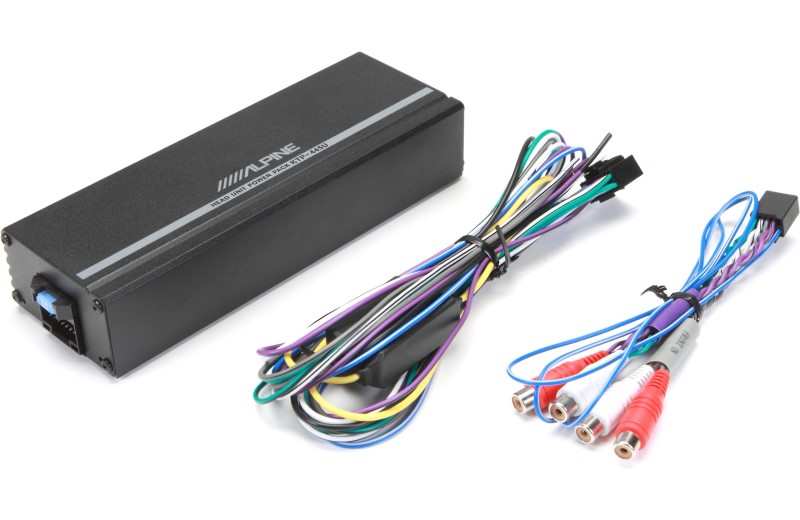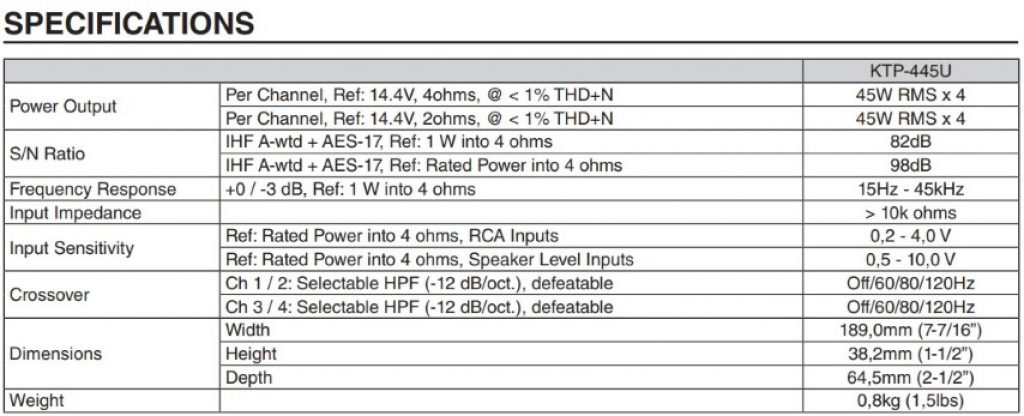Sometimes getting good sound can be really tough – most especially if you have limited space. And it’s a shame, too, because often that means you’ll have to do without.
My, how things have changed!
This little power pack of sound is a modern-day solution to a decades old problem – getting great sound in a tight space. In my Alpine KTP-445U review I’ll provide a detailed an honest review of this fantastic like amp.
Contents
Alpine KTP-445U basics
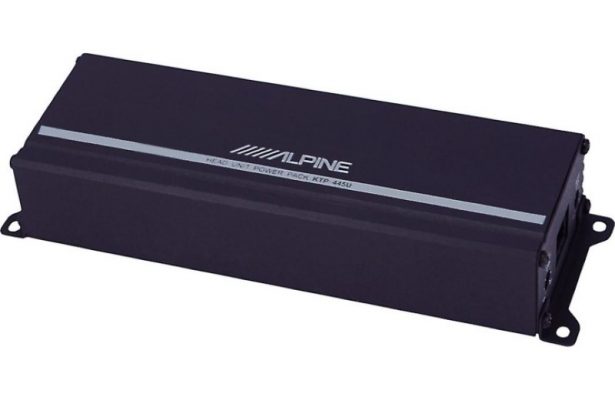 In case you haven’t noticed yet, I’m a big fan of this little guy – and very happy with what Alpine has come up with! I don’t normally expect much from miniaturized amplifiers, but in this case I can honestly say I’m impressed.
In case you haven’t noticed yet, I’m a big fan of this little guy – and very happy with what Alpine has come up with! I don’t normally expect much from miniaturized amplifiers, but in this case I can honestly say I’m impressed.
First off, we need to set the stage by understanding what this little amplifier is and isn’t. It is not an end-all solution for the best audio quality money can buy. Let’s be realistic – you cannot get “perfect sound” in an incredibly tiny package for less than $150.
When it comes to sound, there are always compromises that must be made. It’s important to have reasonable expectations. Any good engineer will tell you the same.
What to bear in mind…
Also, it’s important to remember that as I’ll be explaining below, this is a class D type of amplifier. Class D amps have several pros and cons to be aware of (which I cover in detail). It’s important to remember this when you compare it to other amplifiers you may be thinking about buying.
I’ll be reviewing it based on my extensive knowledge of the technology and the amp both as an engineer and an installer. Also, I’ll be very fair – and very detailed – when I make comparisons to bigger and more expensive amplifiers.
Behind the technology: understanding the KTP-445U amplifier design
In only the last several years class D audio amplifiers have become one of the hottest audio technologies in the audio world. This modern technology has improved greatly since the first class D amplifiers hit the market years ago. I’ve found that despite this many brands still leave a LOT to be desired. Unlike the KTP-445U I have been very disappointed by some I’ve tried.
What is a class D car amp?
Simply put, audio amplifiers are all based off on one or more basic “classes”, or categories that classify the type of design they use. Despite what you might see thanks to advertising, a car amplifier class always fits into one of 3.
These range from Class A (fantastic clarity and ultra-low noise specs, but expensive and a power hog) to Class A/B and now class D. For the most part, any other kind you might run across is just a variation of one of those. (For a “class T” amp is still a class D – that’s just marketing).
Class D amps were once only used for subs but now are mainstream
Until recent years, Class A/B amplifiers were the most common because they’re cost-effective, relatively simple in design, and don’t waste as much power as Class A designs do. Also A/B amps provide low distortion and high power levels for a good watt-per-dollar value.
Despite their good points, conventional (A/B) amplifiers waste a lot of electrical power which is turned into heat rather than power to drive speakers. Today’s amps are still somewhat bulky and heavy due to the large metal body needed to dissipate the heat created.
A class D car amp is a newer type of amplifier technology used to produce audio power more efficiently.
How do class D amps work?
 A Class D amplifier works by “modulating” (chopping up) the incoming audio signal and switching the transistors used to amplify it on and off incredibly quickly. This results in a fantastically efficient design without huge amounts of power being turned into heat like designs from the old days!
A Class D amplifier works by “modulating” (chopping up) the incoming audio signal and switching the transistors used to amplify it on and off incredibly quickly. This results in a fantastically efficient design without huge amounts of power being turned into heat like designs from the old days!
Class D amplifiers are based on a switching circuit design approach. This means the design modulates – or transforms – the incoming audio signal by chopping it up into a series of on-and-off waveforms as the input signal is received.
This is used to switch power-conducting transistors on and off thousands or hundreds of thousands of times per second. Older audio amplifiers (like class A or class A/B) conduct electricity nearly all the time they’re on.
While A/B type amplifiers are about 50-65% efficient, Class D amplifiers can achieve an incredible 85-90% efficiency!
Because of this the amount of power being consumed by a Class D amp is greatly reduced – resulting in no need for a huge, heavy amplifier body or lots of heat being produced. This was a huge step forward in technology.
Additionally, electronic component sizes have evolved to make these amps smaller and smaller. The decades-old problem of “How can I fit an amplifier into a tiny space in my vehicle?” is now just a bad memory.
No longer do you just have to settle for a weak 15W per channel stereo head unit. You’re now able to get many times the sound in a package that’s far smaller than anything imagined possible only 10 years ago.
Alpine vs the competitors
Something you might not be aware of is that there’s a lot of junk out there. Many of today’s car amp brands are no longer selling unique designs of their own. Sadly, many amplifiers on the market today, including compact Class D designs, are rebadged models that share the same internal components and mediocre design and only have minor cosmetic differences on the outside.
Over the years, lower-end brands were bought out by larger companies and exist only for marketing purposes, not for quality.
I’ve even bought one of these competing amps for test purposes (perhaps one day I’ll do a write-up) and was very disappointed with the design & sound quality. Noise levels were unacceptable and upon examining it I realized quickly it was another low-end version of an “amp on a chip” design.
In the audio engineering world, this means shortcuts were taken at the expense of sound quality and performance.
Alpine has relied on its great engineering resources and the KTP-445U is different from the competition because it’s an original and fresh design. I was not disappointed to find it has the trademark Alpine quality and innovation that became my personal favorite over the years.
Also, Alpine doesn’t use misleading power ratings and specifications, unlike other brands. The power ratings and sound quality specifications I’ll go into below are realistic and honest.
This is important to me not just as an installer and an engineer, but because I need to be confident in anything I review and recommend. I know how it feels to spend your hard-earned money on products that disappoint.
KTP-445U features and specifications
Here are some of the most basic specifications you need to know:
Note: the KTP-445U mini amp – despite its tiny size and simple design can drive 2 ohm speakers up to 45 watts each. I was honestly impressed and didn’t expect that.
Size
One of the biggest selling points is its size. The amp measures an amazingly compact 7 7/16″ x 1.5″ x 2.5″ (189 x 38.2 x 64.5 mm) in size. That’s smaller than pretty much any comparable amplifier available anywhere in the world today! I’m not kidding – I was expecting it to be much bigger. Basically all other high-quality Class D amplifiers below $200 today are at least 4 x the size of the Alpine.
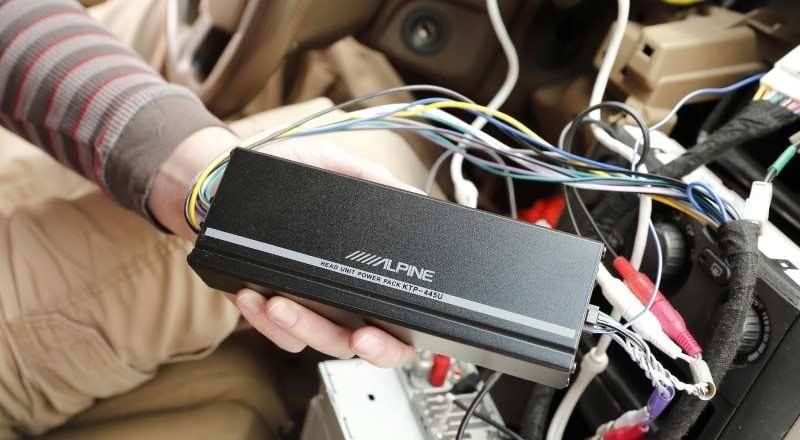
Hard to believe how small it is. An amp with comparable power only a handful of years ago would have been 5 x times bigger. This one is small enough to hold in your hand!
Built-in high-pass crossovers
Originally I had expected the amp to be a “plain Jane” amp with NO features whatsoever, but it turned out I was wrong.
The amp, to my surprise, includes optional high-pass filters with selectable frequencies for the high-pass feature ( 60Hz, 80Hz, or 120Hz) to allow you to cut off speaker-distorting subwoofer bass if you like. Of course, you can always switch if off and run your speakers in “full range” mode if you like, but I normally prefer to block the lower bass frequencies.
My custom-installed 6.5″ speakers can’t handle the lower bass frequencies (they don’t do well below 50 Hz or so, so 60Hz is pretty close) so that’s very important to me.
High and low level inputs
Of course, I didn’t expect the Alpine to disappoint, but again they’ve done a great job in the design. The amp can work with both aftermarket head units via the or RCA inputs OR speaker-level inputs from a factory stereo! In other words, you can use the KTP-445U to get a more powerful and better sound even if you have a factory-installed stereo in your vehicle.
The included color-coded wiring harness makes it easy and it’s a feature I’m sure a lot of buyers just like you will appreciate.
One thing I’ve learned in my years of car stereo installation experience is that the ability to connect to factory-installed stereos is a huge plus. The Alpine can be connected directly to factory speaker wiring to “tap off” and get a good audio signal to feed into the amp.
While not as good as being fed from an aftermarket head unit via the RCA inputs, it’s still a great option and in my experience, when done correctly, still sounds clean and there’s very little distortion or breaking up at higher volumes.
You can also disconnect the factory speakers once the KTP-445U is connected to avoid any distortion issues if that’s a concern for you.
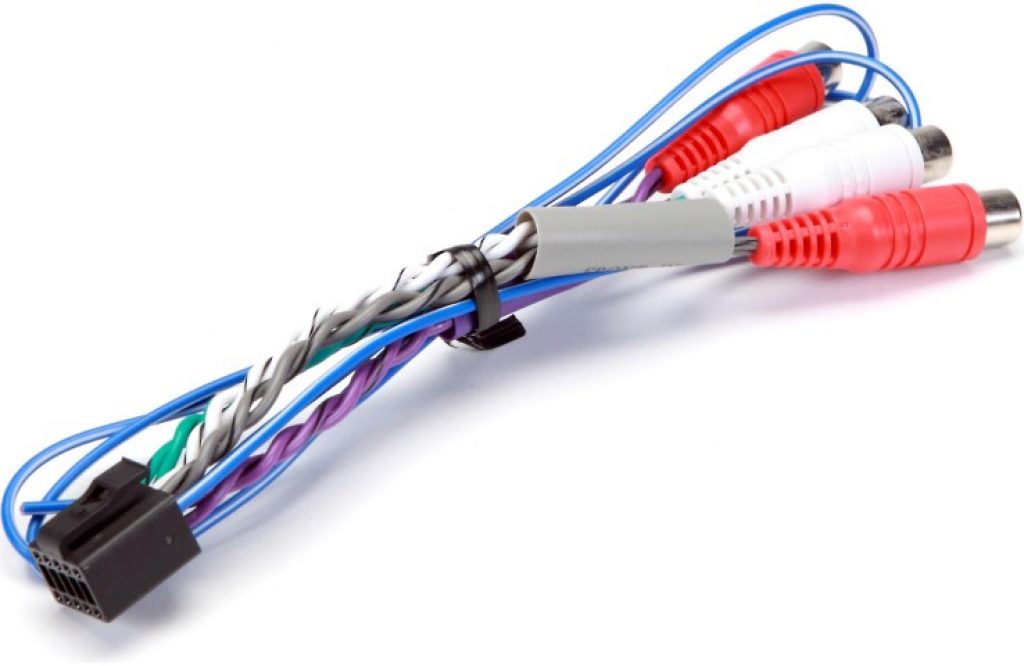 The included signal input harness allows connecting both RCA (low-level) inputs or speaker-level inputs to the amplifier easily. Inputs are color-coded and explained clearly in the owner’s manual. A similar harness is used to connect to the output (to connect to speakers you’d like to use)
The included signal input harness allows connecting both RCA (low-level) inputs or speaker-level inputs to the amplifier easily. Inputs are color-coded and explained clearly in the owner’s manual. A similar harness is used to connect to the output (to connect to speakers you’d like to use)
There are switches for audio controls on the bottom of the amp if you need to choose speaker level inputs or change crossover functions. As a bonus, even if you’re using 4 speakers and only have a 2-channel input, the amp can provide a signal to all 4 outputs. You won’t have to buy a pair of RCA Y-adapters.
To bridge the amp, you’ll also need to set the 2/4 ch. input switch to 2 channel as well.
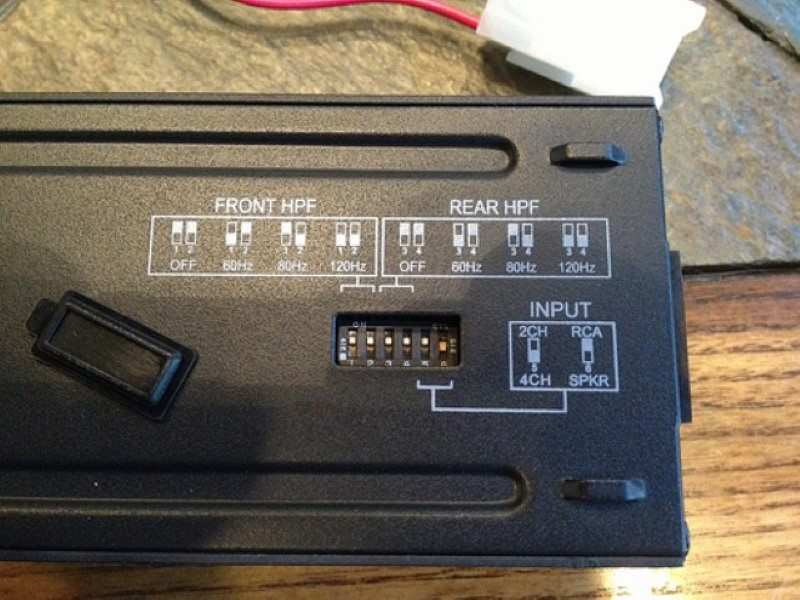
Selectable option switches on the bottom of the amp allow you to adjust the crossover functions or split a stereo input into 4 channels. Also, this is where you must select the audio source before powering up the amp.
Front and rear gain controls
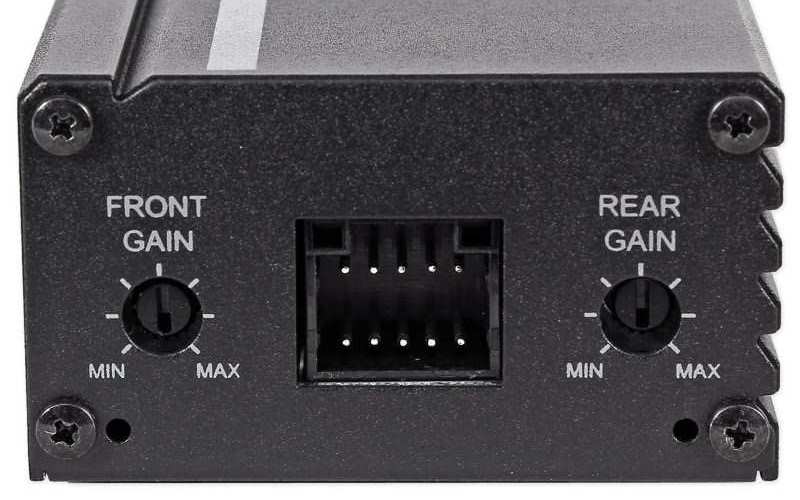 Separate front and rear gain controls allow adjusting the amplification level depending upon the input signal strength you have. Speaker-level inputs, for example, might require turning it down, while RCA-level inputs may require boosting it a bit. It’s highly dependent upon what kind of stereo you have. In either case, it’s easy to adjust. The KTP-444U can accept up to 4V RCA inputs which are considered a “higher end” signal strength for aftermarket units.
Separate front and rear gain controls allow adjusting the amplification level depending upon the input signal strength you have. Speaker-level inputs, for example, might require turning it down, while RCA-level inputs may require boosting it a bit. It’s highly dependent upon what kind of stereo you have. In either case, it’s easy to adjust. The KTP-444U can accept up to 4V RCA inputs which are considered a “higher end” signal strength for aftermarket units.
Not too much I have to say here – the front and rear controls are easy to use and easy to adjust. Also, the gain controls “feel” good because good quality components (potentiometers, which are just adjustable resistors) are used on the circuit board. This means that when you adjust the gain levels it won’t change over time and will have a good “feel” when you turn them.
Power
The amp can deliver up to 45 watts per channel into both 4 or 2-Ohm speakers, which is surprising because most miniature amps in my experience cannot handle 2 Ohm speakers. This means you could add extra speakers in parallel (to a degree) if desired.
It’s important to understand that 45 watts isn’t enough for extreme sound levels or to drive large woofers if that’s your goal. This amp isn’t designed for that.
I’d estimated with a good set of efficient speakers, however, you can get close to around 100dB of clear sound before it begins to give out due to its limits. For most people with normal listening habits, it’s plenty of power and you need not worry.
Sound quality
For me, sound quality is extremely important.
It seems like every little bit of irritating distortion or poor musical reproduction I’ve heard grates my nerves.
I’m happy to report the KPT-445U has great good sound quality and is very impressive for a tiny amp! If you recall what I mentioned earlier, this is a Class D amplifier. The benefits of Class D amplifiers are a fantastic size, great efficiency, and a lower weight, but one of the drawbacks is reduced sound quality.
I can say with certainty (and don’t just trust me on this – check the multitudes of other happy reviews) that the sound quality is very good. Remember when I mentioned earlier about how I bought another brand of car amplifier and was disappointed?
It was because the noise levels (the noise I heard when no music was playing) was far too high compared to the many amplifiers I’ve installed and listened to over the years. Not so with Alpine – they’ve done a great job in minimizing noise.
I can say I was pleasantly surprised. I came into my review of the KTP-445U expecting an “ok” experience but was honestly very impressed with what Alpine has done.
Here’s an excerpt from the company themselves:
In my opinion, this says a lot. Why? Because it takes additional engineering time and manpower – in addition to planning – to make the effort to make better sound quality a design goal rather than a forgotten number on a spec sheet somewhere.
I’d much rather pay a bit more for something I know is designed right from the beginning and I know sounds great rather than just made to be “ok” and barely passable.
And by the way, for you spec nerds like me, the specs on this little amp are great. According to the company, the Power Pack distortion actually decreases at higher frequencies, resulting in a clean and clear signal where your ear is most sensitive to distortion (less than 0.03% THD+N @ 1W, 1% THD+N at rated power).
Installation
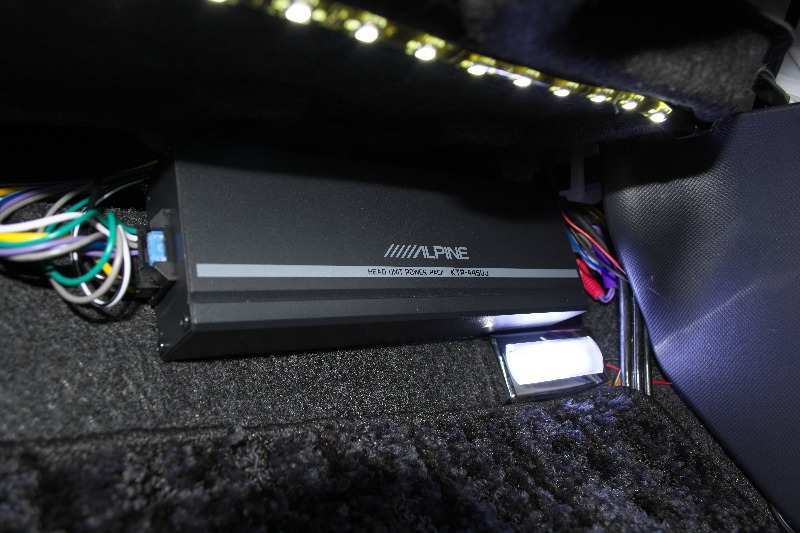
Great for installation under seats and just about any small space you can think of.
The great thing about the size is that you can fit it in incredibly small spaces which were unheard of years ago. A great example is some of today’s vehicles in which there’s extremely tight space inside the dashboard, perhaps beside or behind the current stereo.
It’s a great solution to the most difficult installation problems which years ago would have required either a ton more money to be spent by customers or unfortunately caused some people to just “give up’ as there weren’t any other options.
It’s also a great fit for boats as well but you’d need to ensure it is protected against corrosion and exposure to the air and saltwater since it’s not marine rated. You can mount the tiny powerhouse by using the included zip cable ties to attach it to the nearest available wiring or mount it permanently using the included brackets and self-tapping screws.
Don’t forget that because of its light weight you could also use double-sided adhesive tape or Velcro if desired for convenience.
Note: Because it is so efficient and draws less electrical current than traditional amps, you won’t need to get a heavy-gauge wire installation kit and run extra wire. It’s possible to connect it to a nearby 12V supply from your car stereo, for example.
Accessories included with the KTP-445U
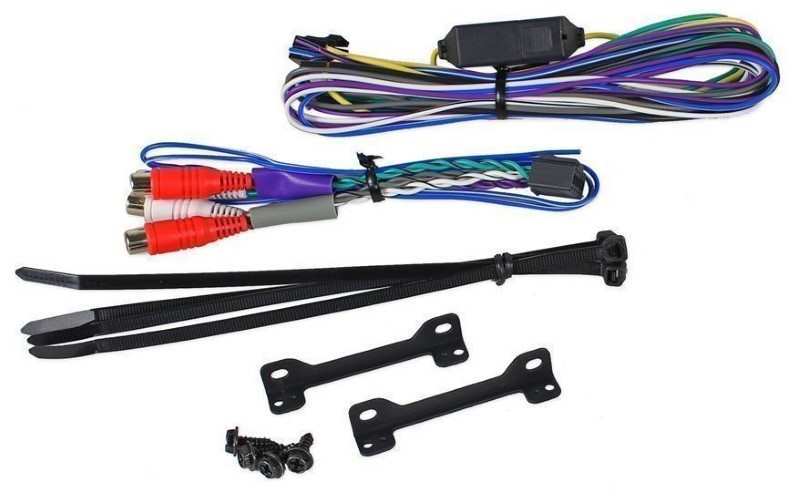
- Mounting brackets (2)
- Self-tapping screws (4)
- Cable ties (2)
- Required wiring harnesses
I would suggest getting a few inexpensive items to make sure you’re better prepared for installation, such as:
- A roll of speaker wire
- 14 or 16 gauge power and negative wire for installations placed further way
- Wire crimp connectors (“butt connectors”) and a crimp tool
- A small bag of 6″ or 8″ zip wire tie
Bridging the amp
Need more power? Amazingly – and to my surprise – it’s not a problem with this amp.
Just switch the 2/4 channel input switch to the 2 ch. input mode. Then connect the output speaker wiring in bridged mode and you’re done!
You’ll have 90W RMS per channel of high-quality sound at your disposal. Honestly, I didn’t expect that for an amp so small, but the engineering quality made all the difference once again.
Just one more reason I’m impressed with it.
KTP-445U vs KTP-445A

The KTP-445A looks very similar to the KTP-445U. However, it’s designed specifically for Alpine head units 2005 and later, not for RCA or high-level inputs from others.
When shopping it’s important to be aware of the KTP-445A model as it can cause a bit of confusion and comes up in search results.
The KTP-445A is a model of the KTP-445U (where “U” stands for universal; “A” stands for Alpine head units) designed only to work with Alpine model car stereos. The wiring harnesses included don’t allow using RCA connectors or standard speaker-level inputs.
Aside from that, both share the same basic design and performance.
There are a few drawbacks to know…
I would have liked to have an optional low-pass crossover feature in addition to the high pass design. Perhaps it was a cost-cutting or design compromise decision that had them remove it. I’m not sure.
I have somewhat mixed feelings regarding the location of the switches used to control sound options. They’re located on the bottom, whereas ideally, they’d be accessible from the side or top. But ultimately that’s a minor complaint.
Review score & summary
All in all, in my opinion, the KTP-445U is a wonderful little 4-channel amplifier with great sound quality. It’s truly a dream come true if you want great sound but have especially limited space.
It’s not for those who need extreme power and volume levels. You can’t drive subwoofers or very high-volume speaker systems with this amp, but what it does it does well!
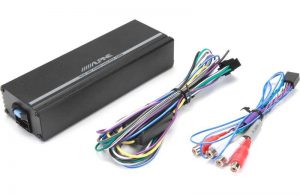 Head over to check out the current price and see the fantastic buyer reviews at Amazon.
Head over to check out the current price and see the fantastic buyer reviews at Amazon.
Overall
-
Quality - 9.5/10
9.5/10
-
Sound quality - 8.7/10
8.7/10
-
Installation ease - 9.5/10
9.5/10
-
Features - 7.5/10
7.5/10
A well-designed and great sounding miniature car amplifier. One of the best compact amps I've seen.
Alpine has done it again with their approach to getting the most power and sound out of a tiny package. It’s a great upgrade for weak aftermarket or factory stereos. Thanks to its design it’s a great general-purpose 4-channel amp that can fit a wide variety of installation and audio system needs. You’re paying a few extra dollars for better sound and better design – and that’s exactly what you’ll get. You won’t be disappointed.
Pros
- Amazingly small size!
- Great sound, low distortion, and low noise design
- Can handle 2 ohm speakers (4 channel mode)
- 4 channel outputs
- Bridgeable to 90W RMS x 2 channels
- Selectable 2/4 channel input switch (no Y adapters required)
- Speaker level inputs
- Installation accessories included
- Great power: 45W/channel
- Built-in optional high-pass crossovers
- Simple installation / no large wire required
Cons
- No low-pass crossovers
- Option switches are located on the bottom as opposed to top or sides
- Could use more zip ties in package
